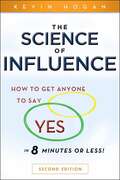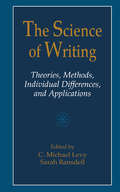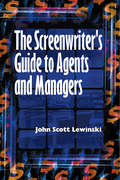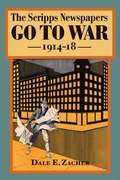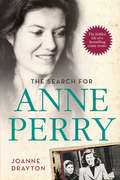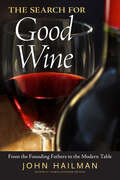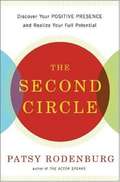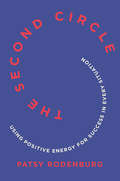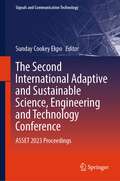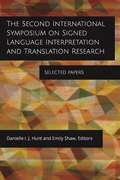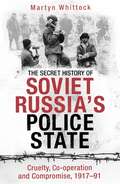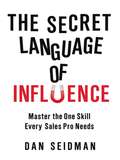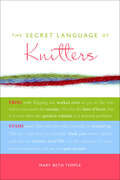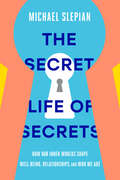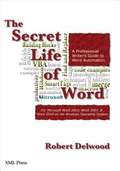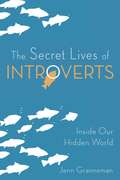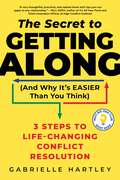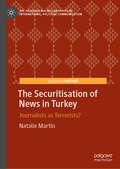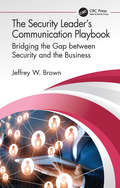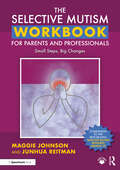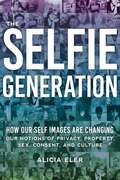- Table View
- List View
The Science of Influence
by Kevin HoganGet customers, clients, and co-workers to say "yes!" in 8 minutes or less This revised second edition by a leading expert of influence continues to teach a proven system of persuasion. Synthesizing the latest research in the field of influence with real-world tested experiences, it presents simple secrets that help readers turn a "no" into a "yes. " Every secret in this book has been rigorously tested, validated, and found reliable. Learn dozens of all-new techniques and strategies for influencing others including how to reduce resistance to rubble Make people feel instantly comfortable in your presence Decode body language, build credibility, and be persistent without being a pain Expert author Kevin Hogan turns the enigmatic art of influence and persuasion into a science anyone can master The amazing secret of The Science of Influence is its simplicity. After you read this book you will immediately understand why people say "no" to you and learn how to turn that "no" into a "yes" from that moment on.
The Science of Influence: How to Get Anyone to Say "Yes" in 8 Minutes or Less!
by Kevin HoganGet customers, clients, and co-workers to say "yes!" in 8 minutes or less This revised second edition by a leading expert of influence continues to teach a proven system of persuasion. Synthesizing the latest research in the field of influence with real-world tested experiences, it presents simple secrets that help readers turn a "no" into a "yes." Every secret in this book has been rigorously tested, validated, and found reliable. Learn dozens of all-new techniques and strategies for influencing others including how to reduce resistance to rubble Make people feel instantly comfortable in your presence Decode body language, build credibility, and be persistent without being a pain Expert author Kevin Hogan turns the enigmatic art of influence and persuasion into a science anyone can master The amazing secret of The Science of Influence is its simplicity. After you read this book you will immediately understand why people say "no" to you and learn how to turn that "no" into a "yes" from that moment on.
The Science of Writing: Theories, Methods, Individual Differences and Applications
by C. Michael Levy Sarah RansdellConceived as the successor to Gregg and Steinberg's Cognitive Processes in Writing, this book takes a multidisciplinary approach to writing research. The authors describe their current thinking and data in such a way that readers in psychology, English, education, and linguistics will find it readable and stimulating. It should serve as a resource book of theory, tools and techniques, and applications that should stimulate and guide the field for the next decade. The chapters showcase approaches taken by active researchers in eight countries. Some of these researchers have published widely in their native language but little of their work has appeared in English-language publications.
The Screenwriter's Guide to Agents and Managers
by John Scott LewinskiThe lessons to be learned from this helpful guide show aspiring screenwriters, television writers, and novelists how to catch an agent's eye and develop a successful scriptwriting career. Step-by-step instructions reveal how to get around the "Catch 22" of the trade-that you can't get an agent until you've sold a script. Interviews with prominent agents and managers disclose how the power brokers choose material, what kinds of writers command their attention, and what they expect from the writers they sign on. Tips on how to write a winning spec script, how to word an effective query letter, how to forge a sound relationship with reps, and other invaluable advice fill this insider's guide.
The Scripps Newspapers Go to War, 1914-18
by Dale ZacherA telling look at the inner workings of one of the nation's most dominant news outlets during wartime In an age before radio and television, E. W. Scripps's ownership of twenty-one newspapers, a major news wire service, and a prominent news syndication service represented the first truly national media organization in the United States. In The Scripps Newspapers Go to War, 1914-18, Dale Zacher details the scope, organization, and character of the mighty Scripps empire during World War I to reveal how the pressures of the market, government censorship, propaganda, and progressivism transformed news coverage during wartime. This volume presents the first systematic look at the daily operations of any major newspaper operation during World War I and provides fascinating accounts of how the papers struggled with competition, their patriotic duties, and internal editorial dissent. The book also engages questions about American neutrality and the newspapers' relationship with President Woodrow Wilson, the move to join the war, and the fallout from the disillusionment of actually experiencing war. Ultimately, Zacher shows how the progressive spirit and political independence at the Scripps newspapers came under attack and was forever changed by this crucial period in American history. A volume in the series The History of Communication, edited by Robert W. McChesney and John C. Nerone
The Search for Anne Perry: The Hidden Life of a Bestselling Crime Writer
by Joanne DraytonIn 1994, director Peter Jackson released the movie Heavenly Creatures, based on a famous 1950s matricide committed in New Zealand by two teenage girls embroiled in an obsessive relationship. The movie launched Jackson's international career. It also forever changed the life of Anne Perry, an award-winning, bestselling crime writer, who at the time of the movie's release was publicly outed at Juliet Hulme, one of the murderers. A new light was now cast, not only on Anne's life but also on her novels, which feature gruesome and violent deaths and confront dark issues, including infanticide and incest.Acclaimed literary biographer Joanne Drayton was given unparalleled access to Anne Perry, her friends, relatives, colleagues, and archives to complete this book. She intersperses the story of her life with an examination of her writing, drawing parallels between Perry's own experiences and her characters and storylines. Anne Perry's books deal with miscarriages of justice, family secrets exposed, punishment, redemption, and forgiveness, themes made all the more poignant in light of her past. She has sold 25 million books worldwide and published in 15 different languages, yet she will now forever be known as a murderer who became a writer of murder stories. The Search for Anne Perry is a gripping account of a life, and provides understanding of the girl Anne was, the adult she became, her compulsion to write, and her view of the world.
The Search for Good Wine: From the Founding Fathers to the Modern Table
by John HailmanThe Search for Good Wine is a highly entertaining and informative book on all aspects of wine and its consumption by nationally-syndicated wine columnist John Hailman, author of the critically-acclaimed Thomas Jefferson on Wine (2006). Hailman explores the wine-drinking experiences and tastes of famous wine-lovers from jolly Ben Franklin and the surprisingly enthusiastic George Washington to Julius Caesar, Sherlock Holmes, and Ernest Hemingway among numerous other famous figures. Hailman also recounts in fascinating detail the exotic life of the founder of the California wine industry, Hungarian Agoston Haraszthy, who introduced Zinfandel to the U.S.Hailman gives calm and reliable guidance on how to deal with snobby wine waiters and how to choose the best wine books and travel guides. He simplifies the ABCs of wine-grape types from the delicate pinot noirs of Oregon to the robust malbecs of Argentina and from the vibrant new whites of Spain to the great reds (old and new) of Italy. The entire book is dedicated to finding values in wine. As Hailman says, "Everyone always wants to know one basic thing: How can you get the best possible wine for the lowest possible price?" His new book is highly practical and effective in answering that eternal question and many more about wine.A judge at the top international wine competitions for over thirty years, Hailman examines those experiences and the value of "blind" tastings. He gives insightful tips on how to select a good wine store, how to decipher wine labels and wine lists, and even how to extract unruly champagne corks without crippling yourself or others. Hailman simplifies wine jargon and effectively demystifies the culture of wine fascination, restoring the consumption of wine to the natural pleasure it really should be.
The Second Circle: This Book Will Transform Your Life, Minute to Minute
by Patsy RodenburgThe world's leading voice and acting coach provides a revolutionary program to focus your energy and connect with other people. Are you as successful as you could be? Are your good ideas appreciated? Could your sex life be more fulfilling? In this high-paced yet lonely world, Patsy Rodenburg teaches you how to communicate more effectively and intimately--at home, at work, at school, and, most importantly, with yourself. Her remarkable program transforms your negative patterns of energy into a positive presence that she calls "the second circle"--the optimal state between the first circle of introversion and self-negation and the third circle of aggression and narcissism. Containing a wealth of insights that will break the habits that constrict your real power, The Second Circle helps you deal with the debilitating and manipulative behaviors of your immediate family, friends, and colleagues while bringing out their best qualities. Filled with easy-to-apply exercises (breathing, voice, posture), The Second Circle, in dealing with such emotional issues as loss, violation, and self-esteem, will begin a journey that will revitalize your life.
The Second Circle: Using Positive Energy For Success In Every Situation
by Patsy RodenburgThe key to unlocking your power—and the inspired life that comes with it—from the renowned voice and acting coach. You know that person: the one with that certain something. And you’ve probably dismissed that something as unattainable, simply innate. But it’s a myth that some are born with “it” and others aren’t. Everybody can have that presence—and the peaceful self-acceptance that powers it. Patsy Rodenburg reveals that the secret is learning to inhabit “the second circle”: the optimal state between the first circle of introversion and self-doubt and the third of aggression and narcissism. She provides exercises to help you break the habits that constrict your real power and to better cope with the negative behaviors and attitudes of those around you. With wisdom and patience, Rodenburg teaches you how to communicate effectively at home, work, school, and—most important—with yourself. The Second Circle will empower you to meet life’s most extraordinary trials with brio and to embrace the joys and challenges of every single day.
The Second Impeachment Report: Materials in Support of H. Res. 24, Impeaching Donald John Trump, President of the United States, for High Crimes and Misdemeanors
by Majority Staff Committee on the JudiciaryWith a foreword by New York Times bestselling author and former confidante of Donald J. Trump, Michael Cohen, the official report of materials supporting the first-ever second impeachment of a President of the United States—complete with US Constitution included. In 2019, Donald Trump became only the third US President to be impeached by the House of Representatives on charges of abuse of power and obstruction of congress. In January 2021, he became the first President in American history to be impeached for a second time. Though no sitting president was ever convicted, will Trump be the first there, too? Still in the midst of the coronavirus pandemic, which the president has also been accused of handling poorly, and an ongoing refusal to concede his loss to rival candidate Joe Biden, Donald Trump is said to have provoked his followers to storm the US Capitol in Washington, DC, resulting in a shocking protest-turned-violent in an effort to stop the official Electoral count in certifying Biden's victory. The unprecedented event led to the deaths of at least five people, as well as the President being banned from all major social media, including Twitter, Facebook, Instagram, and more, due to risk of inciting more violence. This groundbreaking report—released by the House Judiciary Committee, chaired by Jerrold Nadler—covers Trump's conduct leading up to January 6, 2021, the attack on the capitol, his response to the insurrection, and provides a compelling argument as to why there is an immediate need to consider impeachment despite Trump having only seven days left in office.
The Second International Adaptive and Sustainable Science, Engineering and Technology Conference: ASSET 2023 Proceedings (Signals and Communication Technology)
by Sunday Cookey EkpoThis proceedings presents papers from the Second International Adaptive and Sustainable Science, Engineering and Technology Conference (ASSET 2023), which took place simultaneously in Manchester, UK and Ikot Akpaden, Nigeria on 18-20, July 2023. The ASSET conference serves as an interactive forum for the advancement of the practice of adaptive and sustainable systems across the multiple disciplines and specialty areas involved with the science, engineering, and technology of integrated entities, complex systems, and networks. The conference provides an avenue for practitioners, researchers, managers, developers, analysts, educators, and users to exchange innovative ideas, concepts, applications, and lessons learned in addressing domain-specific problems, applications-oriented topics, methodologies, standards and multidisciplinary research opportunities and findings relating to ASSET systems.
The Second International Symposium on Signed Language Interpretation and Translation Research: Selected Papers (Gallaudet Studies In Interpret #18)
by Emily Shaw Danielle I. J. HuntThe Second International Symposium on Signed Language Interpretation and Translation Research was a rare opportunity for hearing and Deaf students, researchers, educators, and practitioners to come together and learn about current research in Interpretation and Translation Studies. These selected papers are comprised of research conducted in places such as Australia, Flanders, France, and Ghana, creating a volume that is international in scope. Editors Danielle I. J. Hunt and Emily Shaw have collected papers that represent the advances in the depth and diversity of knowledge in the field of signed language interpretation and translation research. Chapter topics include the use of haptic signals when interpreting for Deafblind people, the role of French Deaf translators during the 2015 Paris terror attacks, and Deaf employees’ perspectives on interpreting in the workplace. Signed chapter summaries will be available on the Gallaudet University Press YouTube channel upon publication.
The Secret History of Soviet Russia's Police State: Cruelty, Co-operation and Compromise, 1917–91
by Martyn Whittock'[R]eadable and thoughtful . . . does an excellent job of exploring how the murderous political police in all its incarnations defined the Soviet Union, and left a poisonous legacy still with us today'Professor Mark Galeotti, author of The Vory and A Short History of RussiaRepression, control, manipulation and elimination of enemies assisted in the establishment of the Soviet state, and helped maintain it in power, but could not, in the end, prevent its collapse.Citizens of the West have, for the most part, been told a very simplified story of the repressive 'totalitarian' state that was the USSR. In fact, it was sustained by more than just policing and force. No amount of revisionist history can erase the reality of millions controlled, imprisoned and killed, but there was much more to the USSR's one-party state than this. Whittock tells a more complex story of the combination of cruelty, co-operation and compromise required to build and run a one-party state. Much of this is the story of the role played by the secret police in creating and sustaining such a form of government, but it is much more than simply a 'history of the secret police'. This is because the 'police state' which emerged (in which dissent, both real and imaginary, was undoubtedly policed, threatened and ruthlessly eliminated) was more than just the product of the arrests, interrogations, executions and imprisonments carried out by the secret police. The USSR was also made possible by a battle for hearts and minds which led millions of people to feel that they really had benefited from the system and had a stake in the new society.
The Secret History of Soviet Russia's Police State: Cruelty, Co-operation and Compromise, 1917–91
by Martyn Whittock'[R]eadable and thoughtful . . . does an excellent job of exploring how the murderous political police in all its incarnations defined the Soviet Union, and left a poisonous legacy still with us today'Professor Mark Galeotti, author of The Vory and A Short History of RussiaRepression, control, manipulation and elimination of enemies assisted in the establishment of the Soviet state, and helped maintain it in power, but could not, in the end, prevent its collapse.Citizens of the West have, for the most part, been told a very simplified story of the repressive 'totalitarian' state that was the USSR. In fact, it was sustained by more than just policing and force. No amount of revisionist history can erase the reality of millions controlled, imprisoned and killed, but there was much more to the USSR's one-party state than this. Whittock tells a more complex story of the combination of cruelty, co-operation and compromise required to build and run a one-party state. Much of this is the story of the role played by the secret police in creating and sustaining such a form of government, but it is much more than simply a 'history of the secret police'. This is because the 'police state' which emerged (in which dissent, both real and imaginary, was undoubtedly policed, threatened and ruthlessly eliminated) was more than just the product of the arrests, interrogations, executions and imprisonments carried out by the secret police. The USSR was also made possible by a battle for hearts and minds which led millions of people to feel that they really had benefited from the system and had a stake in the new society.
The Secret Language of Influence: Master the One Skill Every Sales Pro Needs
by Dan SeidmanSeidman, a sales trainer and consultant, shows how to identify types of buyers, such as big-picture buyers versus detail-oriented buyers, and how to choose a matching sales message and strategy. In a reader-friendly layout with many checklists and summary points, he describes about 30 distinct strategies for identifying buyer styles and using specific techniques to motivate buyers and overcome resistance. Ideas are illustrated with numerous examples. The last section of the book offers an assessment tool that allows readers to identify their own motivations and decision-making strategies. Annotation ©2012 Book News, Inc. , Portland, OR (booknews. com)
The Secret Language of Knitters
by Mary Beth TempleThe expert knitter and author of Hooked for Life shares an irreverent guide to the loopy world of knitting jargon from &“Acrylic&” to &“Yarn Porn&”. If you&’ve ever wanted to know what knitters really mean when they say &“frog&”, &“WIP&”, or &“stash&”, The Secret Language of Knitters is for you. Written by acclaimed crafting author Mary Beth Temple, this dictionary will make you laugh as you learn the ins and outs of knitting terminology. Ideal for the knitting novice as well as the yarn-obsessed, it includes entries such as: * Design Elements noun: Mistakes. As in &“The fact that one sleeve is five inches longer than the other is not a mistake, it is a design element.&” * Moth noun: The devil incarnate, eater of both stash and finished objects. Should be treated with a zero-tolerance attitude. * Stress Knitting noun: When the going gets tough, the tough get knitting.
The Secret Language of Leadership: How Leaders Inspire Action Through Narrative (Jossey-bass Leadership Ser. #40)
by Stephen DenningA Financial Times Best Business Book of the Year: A guide to sharpening your narrative intelligence from &“the Warren Buffett of business communication&” (Chip Heath, New York Times–bestselling coauthor of The Power of Moments). In this book, the acclaimed author of The Leader&’s Guide to Storytelling introduces the concept of narrative intelligence—an ability to understand, act, and react with agility in the quicksilver world of interacting narratives. Stephen Denning shows why this is key to the central task of leadership, what its dimensions are, and how you can measure it. The book&’s lucid explanations, vivid examples, and practical tips are essential reading for CEOs, managers, change agents, marketers, salespersons, brand managers, politicians, teachers, parents—anyone who is setting out to the change the world. &“Leaders don&’t just execute strategy, they must inspire others to follow . . . This book explains how.&” —Financial Times &“Denning cohesively links the importance of narrative intelligence and telling stories to leadership success.&” —Library Journal
The Secret Life of Secrets: How Our Inner Worlds Shape Well-Being, Relationships, and Who We Are
by Michael Slepian&“If you&’ve ever wondered why we keep secrets and what motivates us to spill them, look no further. Michael Slepian has spent the past decade studying the psychology of secrets, and is ready to reveal his findings to the world.&”—Adam Grant, #1 New York Times bestselling author of Think Again Think of a secret that you&’re keeping from others. It shouldn&’t take long; behavioral scientist Michael Slepian finds that, on average, we are keeping as many as thirteen secrets at any given time. His research involving more than 50,000 participants from around the world shows that the most common secrets include lies we&’ve told, ambitions, addictions, mental health challenges, hidden relationships, and financial struggles.Our secrets can weigh heavily upon us. Yet the burden of secrecy, Slepian argues, rarely stems from the work it takes to keep a secret hidden. Rather, the weight of our secrets comes from carrying them alone, without the support of others. Whether we are motivated to protect our reputation, a relationship, a loved one&’s feelings, or some personal or professional goal, one thing is clear: Holding back some part of our inner world is often lonely and isolating. But it doesn&’t have to be.Filled with fresh insight into one of the most universal—yet least understood—aspects of human behavior, The Secret Life of Secrets sheds a fascinating new light on questions like: At what age do children develop the cognitive capacity for secrecy? Do all secrets come with the same mental load? How can we reconcile our secrets with our human desires to relate, connect, and be known? When should we confess our secrets? Who makes for the ideal confidant? And can keeping certain types of secrets actually enhance our well-being?Drawing on over a decade of original research, Slepian reveals the surprising ways that secrets pervade our lives, and offers science-based strategies that make them easier to live with. The result is a rare window into the inner workings of our minds, our relationships, and our sense of who we are.
The Secret Life of Word
by Robert DelwoodThe Secret Life of Word looks at Microsoft Word from the perspective of technical and other professional writers. It gives writers an in-depth look at the hidden capabilities of Word, and shows how to take advantage of those capabilities without being a programmer. The Secret Life of Word will help you master the full gamut of Word mysteries, including AutoCorrect, QuickParts, BuildingBlocks, macros, Smart Tags, program-less VBA programming, and much more. There's something here for everyone who uses Microsoft Word, from new users to experts.Inside the BookPreface Introduction to Word Automation Creating Macros Find and Replace Fields, Form Fields, and Content Controls AutoCorrect and AutoText/Building Blocks Smart Tags Exchanging Data Code Samples Automation Related Topics Glossary, Bibliography, and Index
The Secret Lives of Introverts: Inside Our Hidden World
by Adrianne Lee Jenn GrannemanAn introvert guide and manifesto for all the quiet ones—and the people who love them. Is there a hidden part of you that no one else sees? Do you have a vivid inner world of thoughts and emotions that your peers and loved ones can’t seem to access? Have you ever been told you’re too "quiet,” "shy,” "boring,” or "awkward”? Are your habits and comfort zones questioned by a society that doesn’t seem to get the real you? If so, you might be an introvert.On behalf of those who have long been misunderstood, rejected, or ignored, fellow introvert Jenn Granneman writes a compassionate vindication-exploring, discovering, and celebrating the secret inner world of introverts that, only until recently, has begun to peek out and emerge into the larger social narrative. Drawing from scientific research, in-depth interviews with experts and other introverts, and her personal story, Granneman reveals the clockwork behind the introvert’s mind-and why so many people get it wrong initially.Whether you are a bona fide introvert, an extrovert anxious to learn how we tick, or a curious ambivert, these revelations will answer the questions you’ve always had: What’s going on when introverts go quiet? What do introvert lovers need to flourish in a relationship? How can introverts find their own brand of fulfillment in the workplace? Do introverts really have a lot to say-and how do we draw it out? How can introverts mine their rich inner worlds of creativity and insight? Why might introverts party on a Friday night but stay home alone all Saturday? How can introverts speak out to defend their needs?With other myths debunked and truths revealed, The Secret Lives of Introverts is an empowering manifesto that guides you toward owning your introversion by working with your nature, rather than against it, in a world where you deserve to be heard.
The Secret to Getting Along (And Why It's Easier Than You Think): 3 Steps to Life-Changing Conflict Resolution
by Gabrielle HartleyNamed as a Next Big Idea Club Must Read!Is it possible to get along better? Yes, with 3 simple steps for conflict resolution!Conflict is everywhere—in our homes, at work, on our social media feeds. But conflict isn't inherently bad… in fact, it's a normal and healthy part of human relationships, but many of us aren't good at managing conflict in our everyday lives. In The Secret to Getting Along (And Why it's Easier Than You Think!), attorney Gabrielle Hartley brings more than two decades of divorce mediation experience to helping you learn how to resolve conflict in ways that strengthen your relationships, reflect your values, and lead to positive outcomes for everyone involved. This practical and accessible guide to everyday conflict resolution will help you:Reframe your approach to conflictFind your way to more harmony and less discordCreate better outcomes even in your most difficult relationshipsExperience more peace even when relationships don't go wellStrengthen your skills in resolving conflicts of all shapes and sizesFeel more connected to the important people in your lifeWhether you're fighting with your partner about housework, struggling to set boundaries with a difficult family member, or dealing with a toxic coworker, The Secret to Getting Along (And Why It's Easier Than You Think!) is a necessary resource for navigating difficult conversations and situations—and finding the solutions that will help you create a peaceful, less stressful, and more fulfilling life.
The Securitisation of News in Turkey: Journalists as Terrorists? (The Palgrave Macmillan Series in International Political Communication)
by Natalie MartinThis book examines why Turkey has become infamous as a repressor of news media freedom. For the past decade or so it has stood alongside China as a notorious jailer of journalists – at the same time as being a candidate state of the EU. The author argues that the reasons for this conundrum are complex and whilst the AKP is responsible for the most recent illiberality, its actions should be taken in the wider context of Turkish politics – and the three way battle for power which has been raging between Kemalists, Kurds and Islamists since the republic was founded in 1923. The AKP are the current winners of this tripartite power struggle and the securitisation of journalists as terrorists is part of that quest. Moreover, whilst securitisation is not new, it has intensified recently as the number of the AKP’s political opponents has proliferated. Securitisation is also a means of delegitimising journalism – and neutralizing any threat to the AKP’s electoral prospects – whilst maintaining a democratic façade on the world stage. Lastly, the book argues that whilst the AKP’s securitisation of news began as a means of quashing the reporting of illiberality against wider political targets, since 2016 it has become a target in its own right. In the battle for power in Turkey, journalism is now one of the many losers.
The Security Leader’s Communication Playbook: Bridging the Gap between Security and the Business (Internal Audit And It Audit Ser.)
by Jeffrey W. BrownThis book is for cybersecurity leaders across all industries and organizations. It is intended to bridge the gap between the data center and the board room. This book examines the multitude of communication challenges that CISOs are faced with every day and provides practical tools to identify your audience, tailor your message and master the art of communicating. Poor communication is one of the top reasons that CISOs fail in their roles. By taking the step to work on your communication and soft skills (the two go hand-in-hand), you will hopefully never join their ranks. This is not a “communication theory” book. It provides just enough practical skills and techniques for security leaders to get the job done. Learn fundamental communication skills and how to apply them to day-to-day challenges like communicating with your peers, your team, business leaders and the board of directors. Learn how to produce meaningful metrics and communicate before, during and after an incident. Regardless of your role in Tech, you will find something of value somewhere along the way in this book.
The Selective Mutism Workbook for Parents and Professionals: Small Steps, Big Changes
by Maggie Johnson Junhua ReitmanThis workbook provides hands-on Activities, Strategies, planning sheets and progress trackers for use with children with selective mutism at home, at school and in the wider community. Written by selective mutism expert Maggie Johnson and parent coach Junhua Reitman, the workbook includes first-hand accounts of how children can overcome SM successfully using the Activities and Strategies described in this book. Activities are organised around the daily routines of school and family life and each Activity is broken into a progression of small steps with appropriate Strategies and an accompanying record sheet to track progress. Activities include: • Using the toilet at school • Attending social gatherings • Organising a successful playdate • Initiating conversation • Talking in the classroom • Eating with peers This workbook is essential reading for parents, professionals and anyone who is looking for a toolkit for selective mutism. It also provides a useful extension to The Selective Mutism Resource Manual, 2nd edition, focusing on the ‘how’ to complement the manual’s ‘what’ and ‘why’. Small steps really do lead to big changes but taking the first step can be the most difficult. This book helps you make that first step.
The Selfie Generation: How Our Self-Images Are Changing Our Notions of Privacy, Sex, Consent, and Culture
by Alicia ElerWhether it's Kim Kardashian uploading picture after picture to Instagram or your roommate posting a mid-vacation shot to Facebook, selfies receive mixed reactions. But are selfies more than, as many critics lament, a symptom of a self-absorbed generation? Millennial Alicia Eler's The Selfie Generation is the first book to delve fully into this ubiquitous and much-maligned part of social media, including why people take them in the first place and the ways they can change how we see ourselves. Eler argues that selfies are just one facet of how we can use digital media to create a personal brand in the modern age. More than just a picture, they are an important part of how we live today. Eler examines all aspects of selfies, online social networks, and the generation that has grown up with them. She looks at how the boundaries between people’s physical and digital lives have blurred with social media; she explores questions of privacy, consent, ownership, and authenticity; and she points out important issues of sexism and double standards wherein women are encouraged to take them but then become subject to criticism and judgment. Alicia discusses the selfie as a paradox-both an image with potential for self-empowerment, yet also a symbol of complacency within surveillance culture The Selfie Generation explores just how much social media has changed the ways that people connect, communicate, and present themselves to the world.

